How to Manage Freelance Writers: A Stress-Free Guide
 The position of “managing editor” has evolved in a crazy way since the advent of digital publications and blogs. And whether you consider yourself an editor or not, the chances that you do some managing editor tasks as a content marketer are high.
Every marketer is working with content creators.
Every marketer is making sure the words and images make sense.
You may not consider yourself an editor, but if you manage other content creators, publish content using specific guidelines, or even proofread on a regular basis, you are an editor … at least in part.
But even though many of us are editors in our own ways, we still get questions like, “What does an editor really do these days?”
For me, these kinds of questions bring up irrational feelings of frustration as I think to myself, “What don’t I do??”
But it’s a valid point—we are no longer in the days of traditional print media, where spelling errors are corrected with a big red pen and paragraphs are picked up and put down like weights in the gym.
The position of “managing editor” has evolved in a crazy way since the advent of digital publications and blogs. And whether you consider yourself an editor or not, the chances that you do some managing editor tasks as a content marketer are high.
Every marketer is working with content creators.
Every marketer is making sure the words and images make sense.
You may not consider yourself an editor, but if you manage other content creators, publish content using specific guidelines, or even proofread on a regular basis, you are an editor … at least in part.
But even though many of us are editors in our own ways, we still get questions like, “What does an editor really do these days?”
For me, these kinds of questions bring up irrational feelings of frustration as I think to myself, “What don’t I do??”
But it’s a valid point—we are no longer in the days of traditional print media, where spelling errors are corrected with a big red pen and paragraphs are picked up and put down like weights in the gym.
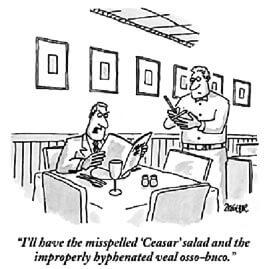 Instead, our jobs are digital and they’re evolving. The myriad tools we have at our fingertips are at once saviors and curses as we attempt to navigate all the tasks and words competing for our attention.
Being an editor comes with a lot of responsibilities, and requires a pretty wide range of skills. Not only do editors need to understand advanced writing techniques, they also need to be a superb manager of people and projects. The writers that create the content for our publications to thrive need leading!
Instead, our jobs are digital and they’re evolving. The myriad tools we have at our fingertips are at once saviors and curses as we attempt to navigate all the tasks and words competing for our attention.
Being an editor comes with a lot of responsibilities, and requires a pretty wide range of skills. Not only do editors need to understand advanced writing techniques, they also need to be a superb manager of people and projects. The writers that create the content for our publications to thrive need leading!
Being an editor comes with a lot of responsibilities, and requires a pretty wide range of skills.
Click To Tweet- Business Strategy (notice I didn’t just say marketing strategy!)
- Project Management
- Editing & Writing Techniques
- Leadership & Relationship Management
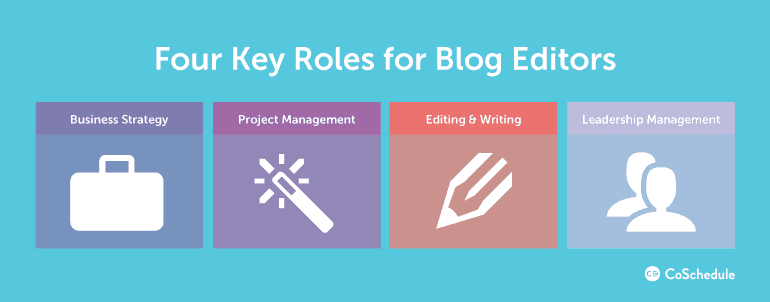 As you can see, editing & writing are only one part of being a successful managing editor. In fact, managing freelance writers starts way before we even hire the writers.
As you can see, editing & writing are only one part of being a successful managing editor. In fact, managing freelance writers starts way before we even hire the writers.
Connect Marketing Strategy to Business Strategy
I could spend all day talking about why every piece of marketing needs to be rooted in your overall business strategy, but the short version is this: If you can’t attach your content marketing activities to the bottom line, you’re not going to have any content marketing activities. That means no writers, no editors, no graphic designers, no programmers, and certainly no social media managers to share your content. I’m not trying to scare you, but it’s important to see the forest for the trees here, especially if you want to take your editorial duties to the next level. So, how can you put bottom-line growth in the forefront of your content marketing activities? Start here:Understand Your Audience
When working with and speaking to marketers, I often pose a question that looks something like this: “Are you a fiction writer? Or are you a marketer?” Fiction writers write for themselves. They’re novelists, and they get to pick the subjects and the characters that make them happy. Not the case for marketers! We have to write for our audiences, not ourselves. So, the first thing to be crystal clear about is who is your audience? What do they need to know? What problems are they looking to solve? How are they getting their information? What format of content do they prefer to consume?
Marketers have to write for our audiences, not ourselves.
Click To TweetSet Measurable Goals
Goals come from the top down. They’re determined by the manager, the c-level executive, or even the owner of the business. That’s because they’re related to bottom-line revenue for the entire business, not just the marketing department. Depending on the structure of your company, you may or may not be a part of the decision-making process when it comes to goals. Regardless, it’s important that you or someone on your team provides some historical metrics so that you can develop future goals for your content marketing efforts. Your goals may look similar to these:- Increase website pageviews by 50%
- Increase email newsletter subscriptions by 100%
- Increase social media referrals by 30%
- Increase organic traffic by 25%
- Increase publishing schedule by 20%
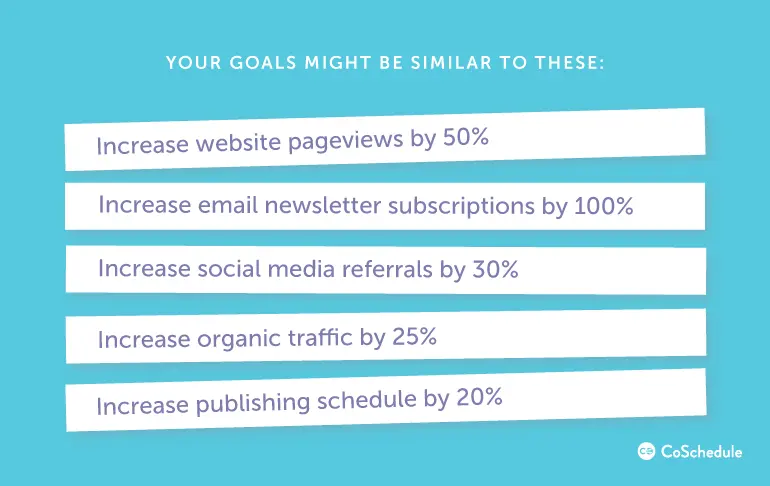 Pick the goals that you can track over time and don’t be afraid to refine them as you go. Even if you’re not in charge, it’s your job to inform the decision makers with actual data and results.
Pick the goals that you can track over time and don’t be afraid to refine them as you go. Even if you’re not in charge, it’s your job to inform the decision makers with actual data and results.
Inform your decision makers with actual data and results.
Click To TweetDevelop Clear Guidelines & Style Guides
The great thing about guidelines is that you can always change them. Okay, that sounds a little nuts to say right away. But it’s my favorite part. Because your tools, your resources, and your goals are always changing, it seems reasonable to accept that you can change your guidelines. But I’ve seen a lot of editors become terrified of creating guidelines and style guides because they think they’re writing them in stone. Not the case! I want to mention this up-front so my type A perfectionists don’t get scared away. Guidelines are important. But they’re not permanent. Make them. Use them. Adjust them. Use the feedback loop to always be making improvements. At the very minimum, make sure your guidelines include:- Audience information
- Goals of your publication
- Expertise you’re looking for
- Tone
- Topic ideas
- Recommended word count
- Instructions on how to submit posts
- Any rules or restrictions
- Make a video to supplement the written ideas
- Provide incentives for submitting posts
- Hide an Easter egg
- Use humor (if it fits with your tone and style)
- Make the process fun
- Embed a form (instead of simply providing an email address)
- Be a human
- Hubspot’s Marketing: Note how they share what they will and will not consider. Also note how clear they are about their process.
- Four Hour Work Week: Note how Tim keeps a conversational but direct tone, explaining exactly what to consider when submitting, what format he wants posts in, and some helpful tips to keep in mind.
- Convince & Convert: Note how Jay developed a custom video to explain the audience and type of content, plus the submission form is embedded directly on the page.
Pay Attention to Project Management
Topics and deadlines and word counts, oh my! Don’t let a long list of to-do’s get in the way of publishing amazing content. Set up a project management system that you can follow throughout your publishing schedule, from communications and deadlines to publish dates and URLs.Use (and Stick To) a Master Editorial Calendar
Some of my favorite publications create certain days of the week for certain types of content, but you don’t have to have to create featured content every day to find value in an editorial calendar. There are tons of tools you can use for this (CoSchedule being my personal favorite, I’m serious!) but you can also start with a simple spreadsheet.Create a Workflow That Works
Even if you’re the only person who manages your editorial process, you need a workflow to stay productive (especially on those days when no amount of coffee can keep you motivated). The best way to do this is to set up an easy, foolproof, step-by-step system that doesn’t require you to think about it every time. Work backwards from publish dates to determine what your process and deadlines will look like. I love to have all posts for the following week edited and scheduled by the Friday before if possible so I don’t have to be panicking about them every day. It’s not always possible, especially if we have timely or sponsored posts to run, but you can corral your writers to meet the deadlines you set out if you plan out your own workflow first. Some tips for that:- Have all posts come in the same way, in the same format, to the same place. That may mean that you have a form that accepts attachments, a Google Drive folder where everyone uploads their finished pieces, or you use a tool that allows writers to drop their drafts right into your CMS.
- Make sure deadlines are clear and are followed. Don’t keep writers around who can’t meet deadlines. There are many reasons for this, but for me, the main reason is because late drafts mean that I have to adjust my workflow. I like to set designated times for review and editing, and I can’t do that if I’m missing content. This goes for initial drafts and any re-written pieces. You must set deadlines for everything!
- Set aside specific time for editing. Editing in batches is often much more productive than editing in piecemeal.
- Use a color-coding system. Perhaps blue means received, yellow means in review, red means awaiting re-write, green means approved, and grey means scheduled. This is especially helpful if you’re working with a team, but even if you’re on your own, it takes the guesswork out of where in the process you are for each piece so you can stay on track.
- Overcommunicate. Writers need a certain level of herding because they’re often working on a lot of different content at once. Make sure that you’re being abundantly clear about where you’re at in the process and what you need from them. This keeps everyone happy and on track.
Are you a blog editor? Here's how to corral your writers.
Click To Tweet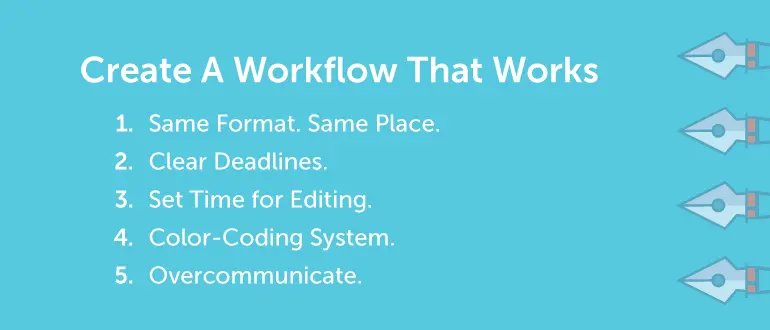 If you have other elements in your process that need to be done, such as graphics and social media messaging, include them in your writer management process even if it means bringing in other designers or social media managers. Having fragmented processes for different teams is ineffective. Create a cohesive process for all of your editorial tasks, even if they involve people outside of your freelance writing team.
Overall, the workflow creation is really about knowing yourself. And as the manager, you have a certain level of authority over what the process is. So please think deeply about what will work best for you, roll out the process to your writers, and stick to it if you can. Trouble comes when you’re always reinventing your process and forcing writers to do the same.
If you have other elements in your process that need to be done, such as graphics and social media messaging, include them in your writer management process even if it means bringing in other designers or social media managers. Having fragmented processes for different teams is ineffective. Create a cohesive process for all of your editorial tasks, even if they involve people outside of your freelance writing team.
Overall, the workflow creation is really about knowing yourself. And as the manager, you have a certain level of authority over what the process is. So please think deeply about what will work best for you, roll out the process to your writers, and stick to it if you can. Trouble comes when you’re always reinventing your process and forcing writers to do the same.
Set Up a Separate Mailbox
If your submission process looks anything like mine, the emails and attachments and questions I get in my email are enough to drive a person mad. And I get it. Writers work hard on their posts, so if you don’t get back to them with approvals right away, they get antsy. But setting up a separate account (such as submissions@ or guestposts@ or editor@) to deal with your articles can help set the expectation among writers (and make you feel a little more sane in the process). You have my permission to set up the process that works for you, and that includes looking at, reviewing, and scheduling content when you have the time and are in the mental space to deal with it. And to make this even easier, consider setting up a separate email box just for your editorial management duties. That will allow you to compartmentalize and batch the work you do with your writers so you don’t get bogged down and pulled away from your other duties. Because I know that if you’re anything like me, you wear many hats and need to focus on different tasks at different times!Nail Your Editing & Writing Techniques
Being a decent writer is really the first thing you need to become an editor, but as you can see it’s not the ONLY thing. And while writing rules change over the course of time, there are several important ones that you should always look out for: There are also always those pesky effect/affect issues, problems with semicolons, and the en-/em-dash debate. If you’re not clear on what you should be editing or simply want to brush up on your editorial chops, I recommend browsing Grammar Girl’s posts or listening to her podcast. CoSchedule also has some editing tips from the writing perspective that will help guide great content. It behooves you to review your expectations with writers from an editing perspective.
There are also always those pesky effect/affect issues, problems with semicolons, and the en-/em-dash debate. If you’re not clear on what you should be editing or simply want to brush up on your editorial chops, I recommend browsing Grammar Girl’s posts or listening to her podcast. CoSchedule also has some editing tips from the writing perspective that will help guide great content. It behooves you to review your expectations with writers from an editing perspective.
It behooves you to review your expectations with writers from an editing perspective.
Click To TweetCut, Cut, and Cut Some More
Many editors follow the 10-15% rule, which means that 10-15% of every article is superfluous and can be cut.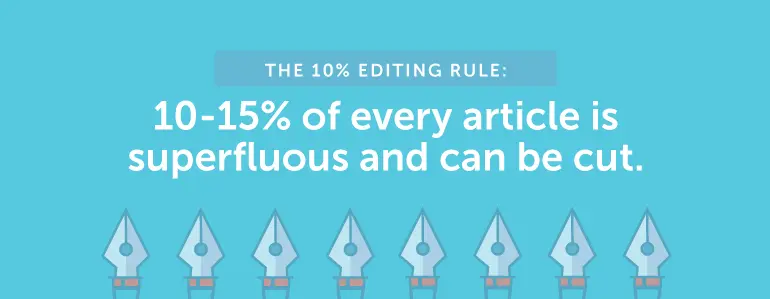 Consider what pieces of your articles either don’t add value or are superfluous and get rid of them. Writing more for the sake of a word-count requirement is not effective, and generally lowers the quality of the piece. If you’re having trouble getting writers to produce enough about a certain topic, then they either don’t know the material or the topic is too narrow to be covered as an article. If the latter is the issue, try other types of media (like video) to explore that topic instead.
Consider what pieces of your articles either don’t add value or are superfluous and get rid of them. Writing more for the sake of a word-count requirement is not effective, and generally lowers the quality of the piece. If you’re having trouble getting writers to produce enough about a certain topic, then they either don’t know the material or the topic is too narrow to be covered as an article. If the latter is the issue, try other types of media (like video) to explore that topic instead.
#Editing Tip: Cut 10-15% from every article.
Click To TweetUnderstand Leadership & Relationship Management
Fortunately (or unfortunately for some!), being a managing editor means you have to work on, well, managing people! That means that you have to refine your leadership and relationship skills, whether you like it or not. Managing relationships is a craft that must be fine-tuned over time, but I wanted to share some ideas that you can start implementing immediately to become a better manager.Managing relationships is a craft that must be fine-tuned over time
Click To TweetBe Honest About Approvals and Edits
Everyone takes a different approach to being an editor. Some focus mostly on grammar, spelling, and general formatting edits. But some of the best editors are the ones who are really great at making sweeping edits within each piece of content to make it sound intelligent and cohesive. Let your writers know what sort of approach you like to take and how that will affect their final written product. This way, they can be prepared for the changes… and their ego doesn’t run the risk of being bruised!Provide Ongoing Feedback
No one likes to receive criticism, but you can lessen the blow of negative feedback by simply providing some sort of feedback, both the good and the bad, every time. That way, your writer doesn’t fear hearing from you (which happens if you’re only getting in touch with bad news) and you’re able to put them in the position of receiving and implementing feedback on an ongoing basis.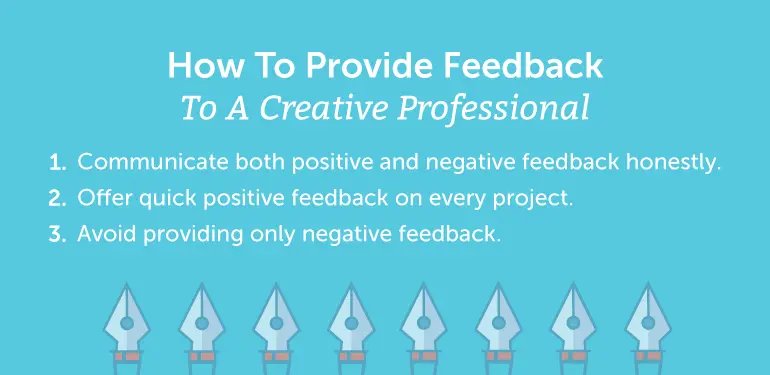 Now I know this puts more of a burden on your as the editor because it means you have to take the time to craft some feedback for each deliverable, but you don’t have to write an expose every time. Even a simple, “Great article, I loved those creative examples you used!” or, “Don’t forget to put compelling subheads to break up your text!” or something as basic as, “You ROCK!” keeps your writers engaged and gets them used to hearing from you as you build the relationship.
Now I know this puts more of a burden on your as the editor because it means you have to take the time to craft some feedback for each deliverable, but you don’t have to write an expose every time. Even a simple, “Great article, I loved those creative examples you used!” or, “Don’t forget to put compelling subheads to break up your text!” or something as basic as, “You ROCK!” keeps your writers engaged and gets them used to hearing from you as you build the relationship.
Good editors give writers positive encouragement.
Click To TweetReceive Ongoing Feedback
The chances that your current editorial system is perfect are slim… because nothing is perfect! Create a calendar for yourself where you’ll check in with your writers and ask them how it’s going. I recommend asking two simple questions:- If you could change anything about our work together, what would it be?
- What new features, tools, or systems would you implement (if any) and why?
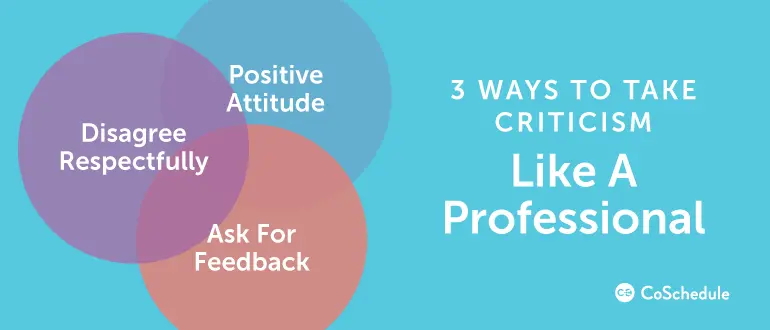 Now, I caution to be careful not to lose sight of the fact that when you ask for feedback, you’ve got to be prepared to hear things you maybe didn’t want to hear or weren’t expecting. You’re in charge, so take each piece of feedback with a grain of salt, but I don’t recommend asking for feedback unless you’re prepared to listen and potentially make changes as a result.
Now, I caution to be careful not to lose sight of the fact that when you ask for feedback, you’ve got to be prepared to hear things you maybe didn’t want to hear or weren’t expecting. You’re in charge, so take each piece of feedback with a grain of salt, but I don’t recommend asking for feedback unless you’re prepared to listen and potentially make changes as a result.
Don't ask for feedback unless you're prepared to listen.
Click To TweetProvide Incentives for Great Work
The worst thing in the world for a manager is losing a great team member. In order to encourage retention among the writers you love, consider finding creative ways to reward them for a job well done. Consider putting a rewards system in place where you celebrate the success of your team when original business goals are met. For example, if you had one breakout article that contributed to a massive increase in pageviews, give that writer something as a thank you. It doesn’t have to be in the form of monetary payment (although everyone loves a little salary bump once in awhile!), but it can be small things like:- A “writer of the month” award
- A shoutout on social media
- A Starbucks (or other) gift card
- A homepage placement
Nurture the Relationship
The hardest thing about being a freelancer is the lack of consistent work. At the same time, good writers have their pick of the crop when it comes to opportunities as the market for great content grows. In addition to providing some sort of small incentive program for your writers, don’t forget about the human element of working with them. Ask them about their day. Say happy birthday. See how their kid is doing after she was out with a cold. A little personal touch goes a long way, especially in what can be a lonely virtual existence as a writer.Pay Your Writers (and Pay Them Well!)
Good writing is truly an art form. And the lack of education on clear communications and writing only makes that art form more valuable. The easiest way to encourage your writers to do good work for you is to compensate them fairly for their services. Now, I understand that many publications provide incredible exposure and that outweighs the prospect of a cash payment. However, the largest and smallest publications alike may consider securing a budget for their writers. This helps develop loyalty among writers and keeps them coming back for more, which is really what you want in this day and age where “writers” are a dime a dozen, but finding great writers is like finding a needle in a haystack.Finding great writers is like finding a needle in a haystack.
Click To TweetWhat is your top content editing tip?
Click To Tweet

